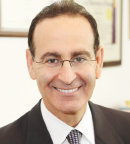On August 13, 2013, more than 100 cancer researchers and physicians from around the world met in Halifax, Nova Scotia, Canada, to discuss 2 challenging problem areas in cancer. One group was focused on the carcinogenic potential of low-dose exposure to chemical mixtures in the environment, and the other group centered their efforts on a broad-spectrum integrative design for cancer prevention and therapy.
Called The Halifax Project, this collaborative effort involved more than 350 researchers from 31 countries, and it was initiated by Getting to Know Cancer, an organization whose mission is to share holistic, scientific knowledge about cancer with key stakeholders who have an interest in the disease (ie, to reduce its occurrence and to illustrate the importance of “broad-spectrum” prophylactic and therapeutic treatment options).

We’ve discovered that targeting a single pathway quite often only kills a large percentage of the tumor, or a subpopulation of a particular genotype, but all too often this still leaves other mutated versions of those cells unscathed as they continue to replicate.— Leroy Lowe, PhD
Tweet this quote
Getting to Know Cancer’s Cofounder and President, Leroy Lowe, PhD, told The ASCO Post that his background prior to his involvement in cancer research was in aerospace engineering. However, after studying the biology of cancer for more than 8 years, he finally understood enough about it to realize there were several unsolved problems, generally because of structural deficiencies. “Today’s researchers are so highly specialized that it doesn’t offer enough opportunities for the kind of integrative work I thought was necessary,” said Dr. Lowe.
Garnering Support From Hundreds of Researchers
“In 2011, I started to reach out to various scientists, looking at a fundamental question of how low-dose exposure to chemicals in the environment could enable the carcinogenic process. I soon had about 20 or so scientists who agreed that low-dose exposure to combinations of certain environmental chemicals was an important issue in oncology, but they were simply not in a position to do anything about such a broad and complicated issue,” Dr. Lowe explained.
“I also began contacting scientists about the heterogeneity of cancers from a therapeutic standpoint. In other words, if the solution to cancer heterogeneity is reaching a broad spectrum of molecular targets, the existing chemistry and approved therapeutics are too toxic to accomplish that. Therefore, we should be looking at softer chemicals that can easily be combined to reach a broader spectrum of high-priority molecular targets,” he suggested.

In the Halifax Project, we had hundreds of prominent scientists and physicians who agreed on the need to develop models of broad-spectrum cancer therapy based on combinations of low-cost, low-toxicity agents aimed at multiple therapeutic targets.— Michael Gilbertson, PhD
Tweet this quote
In 2011, along with Michael Gilbertson, PhD, Dr. Lowe set up the nonprofit organization, Getting to Know Cancer, garnering the support from hundreds of noted researchers around the world.
Broad-Spectrum Approach to Chemotherapy
Asked to describe how the broad-spectrum chemotherapy approach differs from our current strategies, Dr. Lowe said that over the past couple of decades, cancer research has centered primarily on molecular targets for therapeutics, resulting in targeted therapies and the consequent adoption of “personalized” oncology, which has achieved notable successes in some cancers. Significant problems remain with this approach, however, as disease relapse is common, many targeted therapies are highly toxic, and drug prices are extremely high.
“We’ve discovered that targeting a single pathway quite often only kills a large percentage of the tumor, or a subpopulation of a particular genotype, but all too often this still leaves other mutated versions of those cells unschathed as they continue to replicate,” revealed Dr. Lowe. “The heterogeneity of any given cancer causes relapse, which is often treated with combination therapies. However, the combinations that can be used are limited, as they reach their toxicologic limit quickly, and refractory cancers are therefore often unstoppable.”
The broad-spectrum approach is a complementary extension of current science, preferably within the context of a genuinely integrative system, explained Dr. Lowe. “Our researchers tried to identify friendlier chemicals, many of which come from plants and foods. Many of these chemicals can reach multiple targets with little to no toxicity at therapeutic doses,” he added. “The broad-spectrum approach that we describe in our recently published work is designed to simultaneously target many of the key anticancer receptors, pathways, and mechanisms with little-to-no toxicity, which makes a lot of sense. In short, it is intended to address the two major issues of therapeutic resistance and cost.”
Comprehensive Integrative Strategy

Our broad-spectrum treatment methodology makes it possible to address several cancer hallmarks, their growth pathways and multiple molecular targets as opposed to one or two at a time. We developed a systematic approach in which we deliver individualized and innovative treatment regimens in a multitargeted, multidimensional model of treatment based on extensive testing, evaluation, and assessments of our patients.— Keith Block, MD
Tweet this quote
This past year, Dr. Lowe and his associates published a series of related articles along with a capstone paper titled, “Designing a Broad-Spectrum Integrative Approach for Cancer Prevention and Treatment,”1 which sought to make the case that a broad-spectrum integrative strategy might be the best way forward in the battle against cancer. Lead author Keith Block, MD, founder of the Block Center for Integrative Cancer Treatment, Skokie, Illinois, explained that integrative medicine is an approach that addresses the major hallmarks of cancer, and makes use of all appropriate therapeutic lifestyle strategies, health-care professionals, and disciplines to achieve improved outcomes, optimal health, and healing.
“A comprehensive integrative medicine intervention for cancer patients typically includes nutrition education, mind-body medicine, and physical activity components. We also include low cost, low toxicity agents including phytochemicals, botanical and nutritional agents in order to multitarget the hallmarks, and growth pathways that drive cancer. We find this provides patients with a significant clinical impact on treatment,” said Dr. Block.
He continued: “Most cancer approaches focus on a limited set of targets and implement single interventional strategies. In a broad-spectrum methodology, we’re looking at a systematic approach to care in which we deliver individualized regimens in a multitargeted, multidimensional model of treatment based on extensive evaluation and assessments of our patients. We do comprehensive laboratory analysis and a full spectrum of tests to understand each patient’s needs. Along with targeted molecular therapies, we approach chemotherapy from an innovative perspective, for instance including time-sensitive, chronomodulated chemotherapy [delivery of therapeutic agents based on optimal circadian windows to maximize treatment response to maximize dose intensity and outcomes while also minimizing toxicity]. By combining a much more cutting-edge style of infusion, we see diminished toxicity and enhanced efficacy.”
Low-Cost, Low-Toxicity Combinations
Getting to Know Cancer Cofounder and Chief Scientist Dr. Gilbertson told The ASCO Post that the aim of the project was to produce a series of reviews of the cancer hallmarks, which could collectively assess and prioritize the many target choices and also identify nontoxic chemicals (mostly from plants or foods). These nontoxic chemicals could safely be combined to produce an optimized broad-spectrum approach with both prophylactic and therapeutic potential.
“In the Halifax Project, we had hundreds of prominent scientists and physicians who agreed on the need to develop models of broad-spectrum cancer therapy based on combinations of low-cost, low-toxicity agents aimed at multiple therapeutic targets,” declared Dr. Gilbertson.
What Do All Cancer Types Have in Common?
Although there are many types of cancer, all cancer types are known to share 10 common hallmark characteristics:
- The cells in cancer have become genetically unstable.
- Cancerous cells are frequently found in an inflammatory environment.
- Cancerous cells grow uncontrollably.
- Cancerous cells can avoid/ignore antigrowth signaling.
- A self-destruct mechanism in cancerous cells is not functioning properly.
- Cancerous cells have bypassed a replication limit that is not functioning properly.
- The metabolic machinery within cancerous cells is not functioning normally.
- Cancerous cells can evade immune-system surveillance.
- Cells that are oxygen-deprived within a tumor will signal for new blood flow.
- Cancerous cells invade nearby tissues and ultimately enter the bloodstream or lymph system, which allows them to spread and colonize in other parts of the body.
Source: Hanahan D, Weinberg RA: Hallmarks of cancer: The next generation. 144:646-674, 2011.
“It’s important to note,” he continued, “one conundrum that the project’s founder, Dr. Lowe, understood was that pharmaceutical companies are not focused on creating low-cost, low-toxicity combinations of anticancer drugs. So clinical trials of this approach are not ever going to be funded by these companies.”
However, Dr. Lowe added that “there are many progressive clinicians who understand this issue, and some are already taking steps to help their patients with nutritional supplementation, off-label pharmaceuticals, and other methods that are aimed at reaching additional therapeutic targets. So the next step is to find and engage these physicians and implement large-scale, “best-practice” clinical trials using an optimized broad-spectrum protocol and approach.
We think this can be done using a prospective design and a case-study approach across a large number of patients (ie, case survey method). To that end, we are now making plans for prophylactic trials of the broad-spectrum approach (for myelodysplastic syndrome patients who are at high risk of developing acute myeloid leukemia) and for therapeutic trials (for ovarian and pancreatic cancer patients) that we hope will begin in 2017.”
Closing Thoughts
Ultimately, if there is biomarker or biopsy information that pinpoints the most prominent forms of cellular mutation in any given type of cancer, a specific and narrowly targeted therapy that is highly effective may still be the most desirable path to achieve the fastest possible remission. However, a nontoxic, broad-spectrum therapeutic option that can be initiated rapidly after diagnosis and used in concert with a narrowly targeted therapy would still be the best way to reach small or unidentified subpopulations of other types of mutant immortalized cells and reduce the chances of relapse. ■
Disclosure: Drs. Lowe and Gilbertson are cofounders of the nonprofit Gettingtoknowcancer.org and reported no potential conflicts of interest. Dr. Block is the owner and Medical Director of the Block Center for Integrative Cancer Treatment.
Reference

